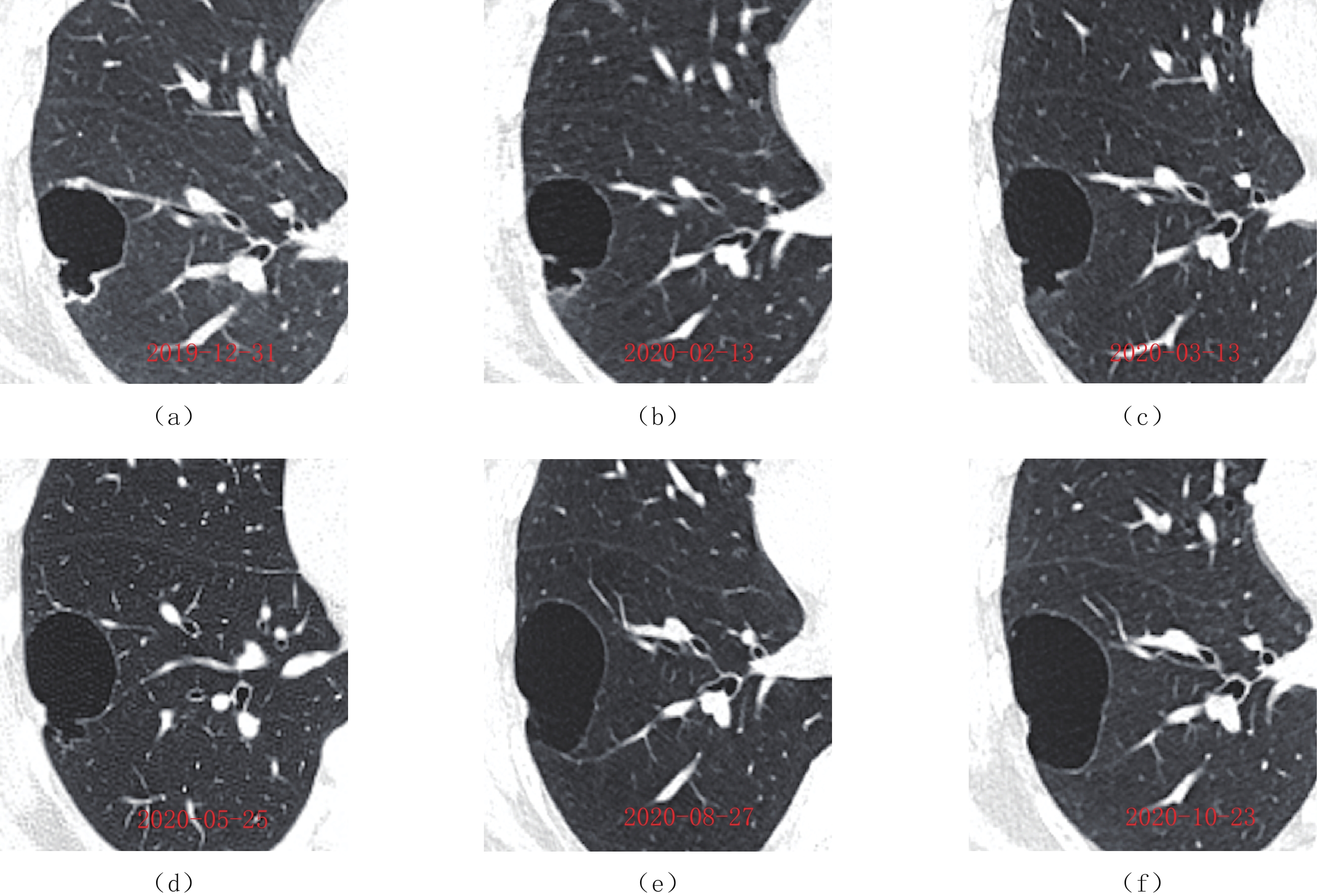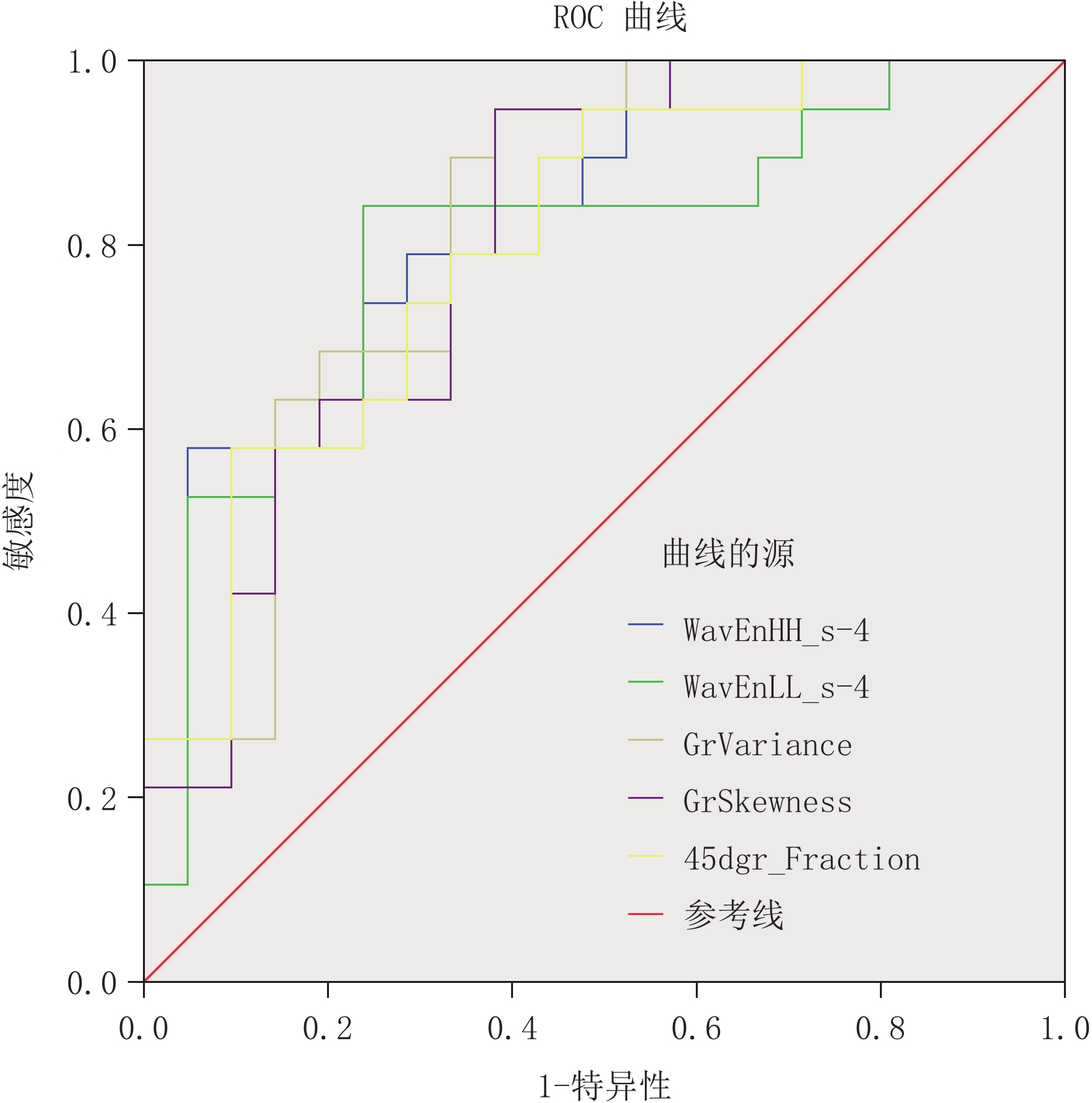Enhanced CT Based Texture Analysis and Machine Learning for Differentiation between Adenolymphoma and Mixed Tumors of the Parotid Gland
-
摘要: 目的:探究基于增强CT纹理分析技术联合机器学习在腮腺腺淋巴瘤与混合瘤鉴别中的应用。方法:回顾性分析40例于本院手术并有完整病理资料的腮腺腺淋巴瘤与混合瘤患者,其中腺淋巴瘤组21例,混合瘤组19例。运用Mazda软件在增强CT静脉期图像上手动勾画病灶最大层面ROI区;应用Fisher系数、POE+ACC、MI及三者联合应用(FPM)的方法,筛选出最佳纹理参数,通过ROC曲线评估其诊断效能;最后采用RDA、PCA和LDA、NDA四种机器学习算法进行分类分析,并分析不同算法的诊断效能。结果:纹理特征参数中腺淋巴瘤组的WavEnHH_s-4、GrVariance、45dgr_Fraction低于混合瘤组,WavEnLL_s-4、GrSkewness高于混合瘤组,且均在组间有统计学意义。ROC曲线显示WavEnLL_s-4的敏感性与特异性较为平衡,AUC值、敏感性、特异性分别为0.797、84.2%、76.2%,具有良好诊断效能;RDA、PCA、LDA、NDA算法的误判率范围分别为30.0%~37.5%、30.0%~37.5%、7.5%~37.5%、5.0%~12.5%,其中误判率最低的是FPM联合NDA分类分析法,为5.0%;准确率、敏感性、特异性、阳性预测值、阴性预测值分别为95.0%、95.2%、94.7%、95.2%和94.7%,分类效能最佳。结论:增强CT纹理分析提取的最佳特征参数在腮腺腺淋巴瘤与混合瘤间具有显著差异,FPM联合NDA分类分析法误判率最低,有助于鉴别腮腺腺淋巴瘤与混合瘤。Abstract: Objective: To explore the application of enhanced computed tomography (CT)-based texture analysis combined with machine learning in the differential diagnosis of adenolymphomas and mixed tumors of the parotid gland. Methods: We retrospectively analyzed 21 and 19 cases of adenolymphomas and mixed tumors of the parotid gland, respectively. Regions of interest (ROI) were chosen on axial enhanced-CT images of the tumor’s maximum cross section using the Mazda software. The optimal texture parameters were selected using Fisher’s coefficient, probability of classification error and average correlation coefficients, mutual information, and a combination of the three. Receiver operating characteristic (ROC) curve analysis was performed to evaluate the diagnostic efficacy. Finally, the texture parameters were classified and analyzed using the following four machine-learning methods: raw data analysis, principal component analysis, linear discriminant analysis, and nonlinear discriminant analysis (NDA). The diagnostic efficiencies of these classification algorithms were analyzed. Results: WavEnHH_s-4, GrVariance, 45dgr_Fraction, WavEnLL_s-4, and GrSkewness were the statistically significant texture feature parameters for differentiating between parotid adenolymphomas and mixed tumors.. ROC curve analysis revealed that WavEnLL_s-4 had a balanced sensitivity and specificity, and the area under the curve, sensitivity, and specificity were 0.797, 84.2%, and 62.5%, respectively. The misclassification rate of NDA (5.0%–12.5%) was lower than that of the other algorithms. The NDA of FPM had the lowest misclassification rate (5.0%); its accuracy, sensitivity, specificity, positive predictive value, and negative predictive value were 95.0%, 95.2%, 94.7%, 95.2, and 94.7, respectively. Conclusion: The optimum enhanced CT-based texture features differed significantly between parotid adenolymphomas and mixed tumors. A combination of FPM and NDA had the lowest misclassification rate; it can contribute toward the identification of parotid adenolymphomas and mixed tumors.
-
Keywords:
- enhanced CT /
- machine learning /
- texture analysis /
- parotid tumor
-
肺癌是全球负担最重的恶性肿瘤之一,据GLOBOCAN估算,2020年全球新发肺癌病例约220万,占全部恶性肿瘤的11.4%,死亡病例约180万,占恶性肿瘤相关死亡的18.0%[1]。提高患者生存率,关键在于早期诊断。
肺癌通常表现为亚实性或实性结节,但一些不常见的表现被逐渐发现,包括以囊性空腔为主要表现的肺癌[2]。这种以囊腔为主要表现的特殊形态的肺癌,1954年由Anderson等[3]率先发现并报道,至今国内外尚未有对囊腔型肺癌的统一定义,多把其定义为以薄壁囊腔为主或实性病灶周围伴有薄壁囊腔的特殊类型肺癌,且囊壁厚度<4 mm,范围超过3/4囊壁[4]。由于这类肺癌的发病率较低,影像及临床医生对该表现肺癌的认识不足,在早期诊断过程中误诊现象较常见。囊性病变通常被认为是良性病变,这是导致囊腔型肺癌漏诊率高的主要原因,因此在评估这种以囊腔为主要表现的特殊类型肺癌时,放射科医生必须熟悉其潜在与恶性肿瘤相关的影像学特征,包括不均匀的囊壁、囊内的分隔、壁结节、囊周围的磨玻璃影和不规则的边缘等[5]。
为此,本文回顾性分析CT上表现为含囊腔并经病理证实为肺癌的51例患者的CT影像及临床资料,以提高对该类特殊类型肺癌的认识及诊断能力。
1. 资料与方法
1.1 研究对象
收集2015年1月至2021年6月期间广州医科大学附属第一医院PACS系统上CT诊断提示含囊腔肺癌、囊腔型/囊腔类肺癌或(含)囊腔病变的患者,根据以下纳入及排除标准[6]。
纳入标准:①经病理证实为肺癌;②CT图像上肺肿瘤具有含气的囊腔,且至少有3/4囊腔壁的厚度≤4 mm。排除标准:①CT图像质量不佳,对观察病灶细微结构存在影响;②首次 CT前已行放射治疗或化疗等任何抗癌治疗。最终纳入51例囊腔型肺癌患者,年龄范围25~82岁,平均(59.98±12.21)岁;其中男性40例,平均年龄(61.13±10.41),女性11例,平均年龄(55.82±17.28)。
1.2 检查方法
采用Siemens SOMATOM Definition AS+128层CT或64层CT及GE Revolution 256排CT进行螺旋CT扫描,在深吸气后屏气状态下自头侧向足侧扫描,扫描范围自肺尖上缘到肋膈角下缘。
Siemens机器扫描参数:管电压120 kV,管电流为自动管电流调制技术,FOV 400 mm×400 mm,矩阵512×512,层厚1 mm,层间隔1 mm。GE Revolution扫描参数:管电压120 kV,管电流为自动管电流调制技术,FOV 350 mm×350 mm,矩阵512×512,层厚0.625 mm,层间隔0.625 mm。
1.3 图像分析
包括病变分布、位置、大小、形态、病变的主体成分(囊腔伴实性、半实性、纯磨玻璃)、主体与囊腔的相对位置关系(Mario分型[7]Ⅰ~Ⅳ 型)、囊腔直径(同一层面最大直径和最大垂直直径之和平均值),囊壁均匀性、囊内壁(光整、不光整)、囊内有无分隔、分叶征、毛刺征、病灶与胸膜的关系、周围血管情况(血管紧贴/走向于病灶边缘、血管进入病灶内)、周围支气管情况(支气管紧贴/走向于病灶边缘、支气管进入病灶内)。
由两名高年资的主治医师对所有患者的CT图像进行全面分析,如意见不统一,再由一名主任医师阅片评估,最终达成一致意见。计数资料使用均数±标准差表达,而计量资料使用频数表达。
2. 结果
2.1 临床及病理特征
51例患者中,仅20例出现临床症状:其中咳嗽19例(37.25%),咳痰16例(31.37%),痰中带血7例(13.73%),发热1例(1.96%),其余31例患者无临床症状。51例患者中,24例(47.06%)有吸烟史;12例(23.5%)患者有肺气肿背景。所有患者均经病理检查确诊肺癌,其中50例经术后病理确诊,1例经两次淋巴结穿刺活检提示转移性肺腺癌(CT图像除主要病灶外无其他异常)。
病理类型:腺癌44例(86.27%),其中微浸润性腺癌7例(13.73%),浸润性腺癌35例(68.63%)(组织学类型:贴壁为主型11例(21.57%)、乳头状为主型(图1(b)、图1(f))8例(15.69%)、腺泡为主型(图2(b))15例(29.41%)且其中2例(3.92%)含微乳头成分占比大于20%,1例(1.96%)未分型),1例(1.96%)化疗后手术病理提示腺癌,1例(1.96%)淋巴结穿刺活检提示肺转移性腺癌;鳞癌5例(9.80%),其中角化性鳞状细胞癌(图2(f)、图2(h))3例(5.89%),非角化性鳞状细胞癌(图1(d)、图2(d))2例(3.92%);大细胞癌1例(1.96%),高级别粘液表皮样癌1例(1.96%)。有9名(17.65%)患者为双原发或多中心肺癌(1例(1.96%)为右上肺、下肺腺癌、左下肺大细胞癌;1例(1.96%)为右上肺浸润性腺癌、左上肺多形性癌(肺浸润性腺癌占90%,巨细胞癌成分占10%);1例(1.96%)为左上肺角化性鳞状细胞癌、右上肺浸润性腺癌;其余6例(11.76%)两个或多个病灶均为腺癌)。
2.2 病灶CT特征及分型
病变肺叶分布的差异不明显,以周围型分布为主。囊腔的平均直径为(4.7±2.7)cm;囊腔类肺癌的CT特征(表1),表现为病灶形态:圆形/类圆形、不规则;病灶主体成分:囊腔伴磨玻璃成分(图1(a))、囊腔伴实性成分(图1(c))、囊腔伴混合成分(图1(e));Mario分型Ⅰ型(图2(a))、Ⅱ型(图2(c))、Ⅲ 型(图2(e))、Ⅳ型(图2(g));囊腔壁:均匀、不均匀;病灶边缘:分叶状、毛刺征;病灶内是否有分隔(图1(e));内壁:光整(图1(c))、毛糙;与胸膜关系:胸膜牵拉(图1(a))、紧贴胸膜;周围血管情况:血管穿行于病灶内(图2(a)黑色箭头所示)、血管紧贴/走向于病灶边缘(图2(a)白色箭头所示);周围支气管情况:支气管穿行于病灶内(图2(a)黑色箭头所示)、支气管紧贴/走向于病灶边缘(图2(a)白色箭头所示)。
表 1 囊腔型肺癌多排螺旋CT征像分析Table 1. Analysis of the signs of cystic lung cancer on multi-slice spiral CTCT征像 类别 数量 构成比/% 形态 圆形/类圆形 29 56.86 不规则 22 43.14 病灶主体成分 囊腔伴磨玻璃成分 20 39.22 囊腔伴实性成分 22 43.14 囊腔伴混合成分 9 17.65 Mario分型 Ⅰ型(结节位于腔外) 24 47.06 Ⅱ型(结节位于腔内) 8 15.69 Ⅲ 型(环壁生长) 9 17.65 Ⅳ 型(多房囊腔与结节混合者) 10 19.61 囊腔壁厚度 均匀 9 17.65 不均匀 42 82.35 有无分隔 有分隔 33 64.71 无分隔 18 35.29 内壁 光整 36 70.59 毛糙 15 29.41 病灶边缘 分叶状 28 54.90 毛刺征 14 27.45 与胸膜关系 胸膜牵拉 24 47.06 紧贴胸膜 11 21.57 周围血管情况 血管穿行于病灶内 8 15.69 血管紧贴/走向于病灶边缘 16 31.37 周围支气管情况 支气管穿行于病灶内 8 15.69 支气管紧贴/走向于病灶边缘 21 41.18 51例患者中,41例在发现病灶时立即进行了手术切除。9例患者在最长达1年半的随访时间内行多次CT检查,病灶均未出现肉眼可见的变化,随后也采取了手术切除。51例患者中,有5例患者淋巴结活检证实出现转移。有1例患者经两次淋巴结穿刺活检提示肺转移性腺癌,确诊后采取化疗AP方案(力比泰+顺铂)进行治疗,经过半年的6个疗程,病灶由原来的不均匀薄壁囊腔变成均匀薄壁囊腔,且囊腔较前增大(图3)。
![]() 图 3 一例囊腔型肺癌接受化疗后的病灶改变(a)~(f)分别于2020-01-17、02-01、03-13、04-08、05-06、05-26执行AP方案(力比泰+顺铂)第1~6疗程化疗。(a)患者化疗前的CT图像,可见右肺下叶前基底段一囊腔病变伴囊壁不均匀增厚;(b)~(e)分别为第2、3、5、6次化疗后CT图像,可见囊壁较前逐渐变薄,囊腔较前增大;(f)第6次化疗后的第2次CT图像,与第6次化疗后的初次图像相比,囊腔进一步增大且薄而均匀,边界清晰。Figure 3. Changes in a lesion after chemotherapy in a case of cystic lung cancer
图 3 一例囊腔型肺癌接受化疗后的病灶改变(a)~(f)分别于2020-01-17、02-01、03-13、04-08、05-06、05-26执行AP方案(力比泰+顺铂)第1~6疗程化疗。(a)患者化疗前的CT图像,可见右肺下叶前基底段一囊腔病变伴囊壁不均匀增厚;(b)~(e)分别为第2、3、5、6次化疗后CT图像,可见囊壁较前逐渐变薄,囊腔较前增大;(f)第6次化疗后的第2次CT图像,与第6次化疗后的初次图像相比,囊腔进一步增大且薄而均匀,边界清晰。Figure 3. Changes in a lesion after chemotherapy in a case of cystic lung cancer3. 讨论
囊腔型肺癌是一种特殊类型的肺癌,目前,国内外尚未明确对囊腔型肺癌进行定义,以往文献中普遍将囊腔型肺癌定义为:一类在肿瘤内部或其边缘可见含气囊腔的特殊表现的肺癌,且认为其壁厚一般小于等于4 mm[8]。囊腔型肺癌的形成机制尚不明确,Aronberg等[9]首先提出了“单向阀门”机制,认为肿瘤发生于细小支气管壁上,并突向管腔,使管腔部分或完全阻塞,形成活瓣效应从而造成远端肺泡膨胀破裂形成囊腔。但也有学者认为是其他原因形成了囊腔,囊腔进一步干扰通气,最后导致肺泡上皮癌变[10]。目前无论何种发生机制均缺乏可靠的组织学证据,还有待进一步研究。
但值得注意的是,本组病例51例中,有12例患者合并有慢性阻塞性肺疾病,有研究表明,肺气肿可能是恶性肿瘤发展的一个促成因素,患有慢性阻塞性肺疾病和肺气肿的人患肺癌的频率可能更高[11],这个证据似乎更加支持肿瘤发生在已有的囊性病变上。
几乎所有的研究都表明,囊腔型肺癌最常见的病理类型是腺癌,但一些少见的病理类型陆续被发现[12]。本组病例中,最多的病理类型为腺癌44例(86.27%),除此之外,还包括5例(9.80%)鳞癌,1例(1.96%)大细胞癌,1例(1.96%)粘液表皮样癌等少见病理类型。然而,尚无直接的证据证明囊腔型肺癌的发生与腺癌的关系,基于“单向阀门机制”,我们推测囊腔性肺癌以腺癌病理类型多见的原因是腺癌的生长方式和速度更利于囊腔的形成。
关于囊腔合并的主体成分差异,主要与肿瘤的生长时期相关,早期肺癌发生时间较短,癌细胞以贴壁生长为主,多呈纯磨玻璃样。进展期肺癌发生时间较长,癌细胞生长范围扩大,填满肺泡单位,实性成分占比多,故进展期多呈实性或混合磨玻璃样结节[5]。本组病例显示,囊腔型肺癌囊壁厚度多不均匀,囊内壁光滑,常见分隔,瘤肺界面清晰,分叶状多见,少有毛刺征,这些表现与腺癌的表现类似。大部分病灶都与胸膜关系密切,大部分病灶有支气管经过囊壁走行,这可能会与肿瘤阻塞支气管,形成活瓣,导致囊腔进一步扩大有关。
本组病例44例腺癌中,7例为微浸润性腺癌,35例为浸润性腺癌,针对浸润性腺癌亚型及分级系统分析[13],其中附壁为主型腺癌11例,该型预后最好;腺泡或乳头状型为主腺癌21例,预后中等;含有大于20% 高级别成分的腺癌2例(本病例为含微乳头状结构),预后最差。
尽管囊腔型肺癌的薄壁囊腔会容易让诊断医师把良性病变放在首位思考,但这是可以避免的陷阱。囊腔型肺癌具有壁不均匀、壁结节和不规则边缘的恶性特征,有助于在CT图像上与良性囊腔病变区分[5]。根据CT表现,可以对囊腔型肺癌进行分型,当前大家普遍公认的分型方法是Mascalchi等[7]提出的形态学分型标准,该方法将囊腔型肺癌分为4型,Ⅰ型:结节位于腔外;Ⅱ型:结节位于腔内;Ⅲ 型:囊腔壁呈环形增厚;Ⅳ 型:多房囊腔与结节混合型。本组病例显示,结节的生长方式以Ⅰ型为主,占24例(47.06%),与王翅鹏等[14]研究的Ⅰ型、Ⅲ 型多见的结果相符。也有部分学者根据主体病变密度不同分为3型:Ⅰ型(磨玻璃密度灶伴囊腔);Ⅱ型(实性结节伴囊腔);Ⅲ 型(磨玻璃、实性结节混合病灶伴囊腔)。本次研究显示囊腔型肺癌的主体部分以实性结节,即Ⅱ型为主,占22例(43.14%),与文献[15]相符。
关于囊腔合并的主体成分差异,主要与肿瘤的生长时期相关,早期肺癌发生时间较短,癌细胞以贴壁生长为主,多呈纯磨玻璃样;进展期肺癌发生时间较长,癌细胞生长范围扩大,填满肺泡单位,实性成分占比多,故进展期多呈实性或混合磨玻璃样结节[5]。本组病例显示,囊腔型肺癌囊壁厚度多不均匀,囊内壁光滑,常见分隔,瘤肺界面清晰,分叶状多见,少有毛刺征,这些表现与腺癌的表现类似。大部分病灶都与胸膜关系密切,大部分病灶有支气管经过囊壁走行,这可能会与肿瘤阻塞支气管,形成活瓣,导致囊腔进一步扩大有关。
当对病变的良恶性难以判断而选择随诊时,若观察到壁增厚或结节增大更加提示恶性,Fintelmann等[16]研究观察到壁结节出现的中位时间为25个月,壁结节的中位数倍增时间为250天,壁增厚的中位数倍增时间为188天。本次研究51例患者中,有9例患者在首次发现囊腔性病变后,分别进行了不同时长的CT随访,最长的随访时间为1年半,平均观察时间为5.3个月,9例病灶均未出现变化,随后采取手术切除,这表明囊腔型肺癌生长速度较缓慢,可有一定的随诊时间。
目前的研究仍然存在一些局限性,首先,本研究纳入的病例较少,其次,它是一项单中心的回顾性研究。针对囊腔型肺癌尚需开展多中心、前瞻性研究,进一步探讨其临床、影像及病理表现,以提高早期诊断的准确性。
4. 结论
综上所述,囊腔型肺癌作为肺癌的特殊表现,由于它具有使诊断医师容易误诊的良性表现——囊腔,所以我们应该对其提高警惕。若囊腔具有不均匀的囊壁、伴有壁结节、周围磨玻璃影、病灶与胸膜关系密切、或支气管经过囊壁走行,应在CT上高度怀疑囊腔型肺癌,若观察到壁增厚或结节增大更加提示恶性,识别这些特征有助于早期准确诊断。
-
表 1 腮腺腺淋巴瘤与混合瘤间最佳纹理特征参数比较
Table 1 Comparison of the optimal texture feature parameters between parotid adenolymphomas and mixed tumors
参数 组别 统计检验 腺淋巴瘤组 混合瘤组 t/Z P WavEnHH_s-4 4.162±1.908 7.493±3.157 -4.084 <0.01 WavEnLL_s-4 21044.469±3887.164 16649.289±4309.226 3.392 0.002 GrVariance 0.185±0.046 0.236±0.033 -4.055 <0.01 GrSkewness 1.996±0.516 1.475±0.295 -3.291 0.001 45 dgr_Fraction 0.328±0.080 0.422±0.074 -3.854 <0.01 表 2 腮腺腺淋巴瘤与混合瘤间最佳纹理特征参数的诊断效能
Table 2 Diagnostic performance of the optimal texture feature parameters for parotid adenolymphomas and mixed tumors
参数 AUC 阈值 敏感性/% 特异性/% P WavEnHH_s-4 0.827 4.979 84.2 66.7 <0.01 WavEnLL_s-4 0.797 19227.148 84.2 76.2 0.001 GrVariance 0.815 0.200 89.5 66.7 0.001 GrSkewness 0.805 1.819 94.7 61.9 0.001 45 dgr_Fraction 0.802 0.384 73.7 71.4 0.001 表 3 腮腺腺淋巴瘤与混合瘤间不同机器学习算法的误判率
Table 3 False-positive rates of different machine-learning algorithms for parotid adenolymphomas and mixed tumors
组别 RDA/% PCA/% LDA/% NDA/% Fisher 37.5(15/40) 37.5(15/40) 10.0(4/40) 7.5(3/40) POE+ACC 35.0(14/40) 30.0(12/40) 22.5(9/40) 10.0(4/40) MI 30.0(12/40) 30.0(12/40) 37.5(15/40) 12.5(5/40) FPM 35.0(14/40) 32.5(13/40) 7.5(3/40) 5.0(2/40) 表 4 腮腺腺淋巴瘤与混合瘤间不同机器学习算法的效能比较
Table 4 Comparison of the performance of different machine-learning algorithms for parotid adenolymphomas and mixed tumors
分类算法 准确率/% 敏感性/% 特异性/% 阳性预测值 阴性预测值 Fisher/RDA 62.5 61.9 63.2 65.0 60.0 Fisher/PCA 62.5 61.9 63.2 65.0 60.0 Fisher/LDA 90.0 95.2 84.2 87.0 94.1 Fisher/NDA 92.5 90.5 94.7 95.0 90.0 POE+ACC/RDA 65.0 76.2 52.6 64.0 66.7 POE+ACC/PCA 70.0 76.2 63.2 69.6 70.6 POE+ACC/LDA 77.5 76.2 78.9 80.0 75.0 POE+ACC/NDA 90.0 85.7 94.7 94.7 85.7 MI/RDA 70.0 76.2 63.2 69.6 70.6 MI/PCA 70.0 76.2 63.2 69.6 70.6 MI/LDA 62.5 66.7 57.9 63.6 61.1 MI/NDA 87.5 81.0 94.7 94.4 81.8 FPM/RDA 65.0 66.7 63.2 66.7 63.2 FPM/PCA 67.5 71.4 63.2 68.2 66.7 FPM/LDA 92.5 95.2 89.5 90.9 94.4 FPM/NDA 95.0 95.2 94.7 95.2 94.7 -
[1] YAMAMOTO T, KIMURA H, HAYASHI K, et al. Pseudo-continuous arterial spin labeling MR images in Warthin tumors and pleomorphic adenomas of the parotid gland: Qualitative and quantitative analyses and their correlation with histopathologic and DWI and dynamic contrast enhanced MRI findings[J]. Neuroradiology, 2018, 60(8): 803−812. doi: 10.1007/s00234-018-2046-9
[2] ZHENG C Y, CAO R, GAO M H, et al. Comparison of surgical techniques for benign parotid tumours: A multicentre retrospective study[J]. International Journal of Oral & Maxillofacial Surgery, 2018, 48(2): 187−192.
[3] 胡涛, 刘琼, 邹玉坚, 等. 扩散峰度成像及动态增强MRI鉴别腮腺多形性腺瘤与Warthin瘤[J]. 放射学实践, 2021,36(9): 1089−1094. HU T, LIU Q, ZOU Y J, et al. Application value of DKI and DEC-MRI in the differential diagnosis of parotid pleomorphic adenoma and Warthin tumor[J]. Journal of Radiology Practice, 2021, 36(9): 1089−1094. (in Chinese).
[4] PARK H J, LEE S M, SONG J W, et al. Texture-based automated quantitative assessment of regional patterns on initial CT in patients with idiopathic pulmonary fibrosis: Relationship to decline in forced vital capacity[J]. American Journal of Roentgenology, 2016, 207(5): 976−983. doi: 10.2214/AJR.16.16054
[5] AHN S J, KIM J H, PARK S J, et al. Prediction of the therapeutic response after FOLFOX and FOLFIRI treatment for patients with liver metastasis from colorectal cancer using computerized CT texture analysis[J]. European Journal of Radiology, 2016, 85: 1867−1874. doi: 10.1016/j.ejrad.2016.08.014
[6] 刘文华, 张衡, 李敏, 等. CT图像纹理分析鉴别诊断腮腺混合瘤与腺淋巴瘤[J]. 临床放射学杂志, 2019,38(12): 2271−2274. LIU W H, ZHANG H, LI M, et al. CT texture analysis in the differential diagnosis of mixed tumor of parotid gland and adenolymphoma[J]. Journal of Clinical Radiology, 2019, 38(12): 2271−2274. (in Chinese).
[7] 任思桐, 李小虎, 刘斌, 等. CT平扫图像纹理分析鉴别腮腺多形性腺瘤与恶性肿瘤的初步研究[J]. CT理论与应用研究, 2019,28(6): 685−691. DOI: 10.15953/j.1004-4140.2019.28.06.06. REN S T, LI X H, LIU B, et al. Preliminary study on differentiating pleomorphic adenoma and malignant tumors of the parotid gland by texture analysis of non-enhanced CT images[J]. CT Theory and Applications, 2019, 28(6): 685−691. DOI: 10.15953/j.1004-4140.2019.28.06.06. (in Chinese).
[8] 茂盛, 王嗣伟, 晋丹丹, 等. 腮腺多形性腺瘤与腺淋巴瘤的CT影像特征及对比分析[J]. 实用放射学杂志, 2019,33(1): 28−46. MAO S, WANG S W, JIN D D, et al. CT imaging characteristics and comparative analysis of parotid pleomorphic adeonoma and adenolymphoma[J]. Journal of Practical Radiology, 2019, 33(1): 28−46. (in Chinese).
[9] 茅枭骁, 征锦. CT纹理分析技术在甲状腺结节影像研究中的应用进展[J]. 医疗卫生装备, 2020,41(12): 97−100. MAO X X, ZHENG J. Research progress of CT texture analysis for imaging studies of thyroid nodules[J]. Medical and Health Equipment, 2020, 41(12): 97−100. (in Chinese).
[10] 任继亮, 吴颖为, 陶晓峰, 等. 常规MRI纹理分析鉴别诊断眼眶淋巴瘤与炎性假瘤[J]. 中国医学影像技术, 2017,33: 980−984. REN J L, WU Y W, TAO X F, et al. MRI texture analysis in differential diagnosis of orbital lymphoma and inflammatory pseudotumor[J]. Chinese Journal of Medical Imaging Technology, 2017, 33: 980−984. (in Chinese).
[11] DODGSON T, MEDICINES M D, SCHEDAR N, et al. Can quantitative CT texture analysis be used to differentiate fat-poor renal policewoman from renal cell carcinoma on enhancement CT images[J]. Radiology, 2015, 276(3): 787−796. doi: 10.1148/radiol.2015142215
[12] SUDARSHAN V K, MOOKIAH M R, ACHARYA U R, et al. Application of wavelet techniques for cancer diagnosis using ultrasound images: A review[J]. Computers in Biology & Medicine, 2016, 69: 97−111.
[13] 徐圆, 段钰, 吴晶涛, 等. 基于CT增强扫描的纹理分析技术鉴别肾脏透明细胞癌恶性程度的可行性研究[J]. 临床放射学杂志, 2019,38: 1693−1697. XU Y, DUAN Y, WU J T, et al. Preoperative assessment of pathological grade of clear cell renal cell carcinoma by texture analysis based on CT enhanced images[J]. Journal of Clinical Radiology, 2019, 38: 1693−1697. (in Chinese).
[14] 周明, 钱斌, 翟晓东. 腮腺腺淋巴瘤与多形性腺瘤的双期增强CT表现与鉴别[J]. 临床放射学杂志, 2012,31: 1243−1246. ZHOU M, QIAN B, ZHAI X D. CT differential diagnosis between parotid gland lymphoma and pleomorphic adenoma[J]. Journal of Clinical Radiology, 2012, 31: 1243−1246. (in Chinese).
[15] 余先超, 孙宇凤, 李鹏, 等. 影像组学在腮腺多形性腺瘤与腺淋巴瘤鉴别诊断中的应用[J]. 现代肿瘤医学, 2021,29(5): 837−840. doi: 10.3969/j.issn.1672-4992.2021.05.025 YU X C, SUN Y F, LI P, et al. Application of radiomics in the differential diagnosis of parotid pleomorphic adenoma and adenolymphoma of the parotid gland[J]. Modern Oncology, 2021, 29(5): 837−840. (in Chinese). doi: 10.3969/j.issn.1672-4992.2021.05.025
[16] 尹进学, 汤日杰, 钟熹, 等. 常规T2WI纹理分析预测早期宫颈鳞癌盆腔淋巴结转移的价值[J]. 临床放射学杂志, 2020,39: 358−362. YIN J X, TANG R J, ZHONG X, et al. Value of conventional T2-weighted images texture analysis in predicting pelvic lymph node metastasis in early-stage cervical cancer[J]. Journal of Clinical Radiology, 2020, 39: 358−362. (in Chinese).
[17] 徐圆, 段钰, 曹正业, 等. CT纹理组学联合机器学习预测肺腺癌淋巴结转移[J]. 临床放射学杂志, 2020,39: 691−695. XU Y, DUAN Y, CAO Z Y, et al. Value of texture analysis combined with machine learning based on enhanced CT of lung adenocarcinoma in prediction of lymph node metastasis[J]. Journal of Clinical Radiology, 2020, 39: 691−695. (in Chinese).




 下载:
下载:






